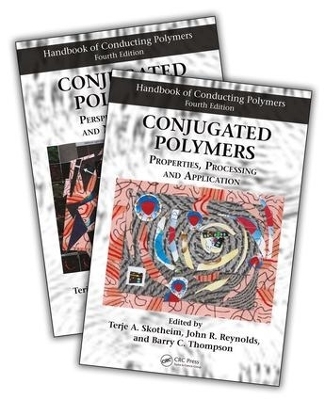
Handbook of Conducting Polymers, Fourth Edition - 2 Volume Set
CRC Press
978-1-138-06551-2 (ISBN)
In the last 10 years there have been major advances in fundamental understanding and applications and a vast portfolio of new polymer structures with unique and tailored properties was developed. Work moved from a chemical repeat unit structure to one more based on structural control, new polymerization methodologies, properties, processing, and applications. The 4th Edition takes this into account and will be completely rewritten and reorganized, focusing on spin coating, spray coating, blade/slot die coating, layer-by-layer assembly, and fiber spinning methods; property characterizations of redox, interfacial, electrical, and optical phenomena; and commercial applications.
Terje A. Skotheim is the founder of Lightsense and has a successful record in developing new technologies and launching new products in fields as diverse as advanced lithium-sulfur batteries, MEMS devices, photovoltaic cells, and biosensors, through several startups. His research interests have spanned across several disciplines in materials science, including conducting polymers, semiconductors, ion conductors and diamond-like carbon. He has held research positions and co-founded companies in Europe and the US, and was head of the conducting polymer group at DOE’s Brookhaven National Laboratory before launching his career as an entrepreneur. He received his B.S. in physics from the Massachusetts Institute Technology and his Ph.D. in physics from the University of California at Berkeley. John R. Reynolds, a native Californian, obtained his B.S. in Chemistry at San Jose State University (1979) followed by his M.S. (1982) and Ph.D. (1984) in Polymer Science and Engineering at the University of Massachusetts. He became interested in the field of conducting and electroactive polymers through a position with the IBM Research Laboratories in the late 1970s. After developing his own research effort at The University of Texas at Arlington (1984-1991), he moved to the University of Florida where he was a Professor of Chemistry and Associate Director of the Center for Macromolecular Science and Engineering until Spring 2012, when his group moved to Georgia Tech where he is a Professor of Chemistry and Biochemistry, and Materials Science and Engineering. He serves as Director of the Georgia Tech Polymer Network (GTPN) and is a member of the Center for Organic Photonics and Electronics (COPE) management team. Barry C. Thompson was born in Milwaukee, Wisconsin in 1977 and moved to Gallipolis, Ohio at a young age, where he attended elementary and high school. Barry then attended the University of Rio Grande in Rio Grande, Ohio, where he majored in Chemistry and Physics and minored in Mathematics. After completing his undergraduate studies at Rio Grande, Barry moved to the University of Florida to pursue a Ph.D. in Chemistry with Prof. John R. Reynolds as an NSF Graduate Research Fellow. During his Ph.D. studies, Barry focused on the design and synthesis of electroactive conjugated polymers for electrochromic and photovoltaic applications. Upon completion of his Ph.D. in 2005, Barry moved to Prof. Jean Fréchet’s lab at UC Berkeley to further pursue his interests in polymer-based photovoltaics as an ACS-PRF Postdoctoral Fellow. After a three-year stay at Berkeley, Barry moved to the University of Southern California, Department of Chemistry and Loker Hydrocarbon Research Institute as an Assistant Professor of Chemistry. Barry was promoted to Associate Professor with Tenure in 2015.
CONDUCTING POLYMERS: PERSPECTIVE, THEORY, AND NEW MATERIALS
Perspective and Overview. History of CPs and the HBCP. Perspective on the CP Physics. Perspective on the CP Chemistry. Theory of Conjugated Polymers. Polymer and Materials Chemistry. Polyacetylenes. Conjugated Ladder Polymers. Polythiophenes. Conjugated Polyelectrolytes. Donor Acceptor Polymers. Direct Arylation. Vapor Phase Polymerization. Conjugated Block Copolymers. Selenophenes, Tellurophenes, etc. Continuous Flow Processing. Metal Containing Conjugated Polymers. Boron Containing Conjugated Polymers. Conjugated Oligomers. n-Type Conjugated Polymers. Photorefractive Polymers.
CONDUCTING POLYMERS: PROPERTIES, PROCESSING, AND APPLICATIONS
Properties and Characterization of Conjugated Polymers. Photophysics. Conducting Polymers. Transport in Conjugated Polymers. Thermoelectrics. Electrochemistry of Conducting Polymers. Electrochromic Polymers. Mechanical Properties of Conjugated Polymers. Photorefractive Polymers. Optoelectronic Polymers. Processing and Morphology of Conjugated Polymers. Printing. Thermal Processing. Morphology Evolution. Conducting Polymer Composites. Oligomer Based Film Structure. Thin Film Structure. Soft X-ray Structural Characterization (RoXS). OFET Applications. Polymers for Organic Photovoltaics. Organic Photovoltaics Architecture. Organic Photovoltaics. Applications of Conjugated Polymers. Conjugated Polymer Sensors. Electrochromic Polymer Devices. Electronic Skin. Electrochemical Devices. Bio- Applications. Redox Active Polymers. Supercapacitors. Actuators and Artificial Muscles. Industrial Status of PEDVT. Aerospace Applications.
| Reihe/Serie | Handbook of Conducting Polymers, Fourth Edition |
|---|---|
| Zusatzinfo | 63 Tables, black and white; 804 Illustrations, black and white |
| Verlagsort | London |
| Sprache | englisch |
| Maße | 178 x 254 mm |
| Gewicht | 3356 g |
| Themenwelt | Naturwissenschaften ► Chemie ► Organische Chemie |
| Technik ► Elektrotechnik / Energietechnik | |
| ISBN-10 | 1-138-06551-X / 113806551X |
| ISBN-13 | 978-1-138-06551-2 / 9781138065512 |
| Zustand | Neuware |
| Haben Sie eine Frage zum Produkt? |
aus dem Bereich

![Organic Chemistry plus Pearson Mastering Chemistry with Pearson eText [Global Edition] - Leroy Wade; Jan Simek](/media/110496757)
